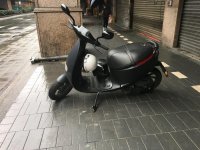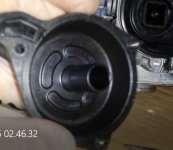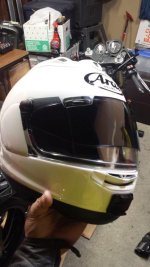Session 23: Last two carb diaphragms
Had some free time today and went to the bat cave to tidy up the tools. It got rather disorganized over the past months as I've been working on a bunch of projects at my mother's rentals like replacing furnaces, water heater and faucets, fence mending, repairing a garage door opener, window blinds, etc. It's never-ending. It's hard to find time for the RVF.
Anyways, I had some free time today to square away the tool chests. It felt good to get personal time. Organizing tools into their labelled drawers helped me track what I have on hand. I was happy to locate my missing RVF spark plug wrench. And I also uncovered a bag of allen wrenches. I now have maybe 5 full sets of inch allen drivers. Not so useful. Oh and I have 3 feeler gauges for some unknown reason!
Once the work space was tidy and swept, I revisited the carb assembly which have been beckoning for attention since June of last year. The last time I touched them I removed the float bowls and two of the diaphragm covers. To be honest, the complexity of the carbs still baffles and intimidates me because I don't fully understand all the parts and how they function.
I removed the remaining two diaphragm covers. Fingers crossed the rubbers would be in decent shape like the first pair as I haven't found spares anywhere online.
Three phillips panhead screws hold the black cover in place. Why are they black and not silver like everything else? They feel and sound metallic but maybe they're glass filled plastic. I carefully cracked the screws careful not to strip out the soft metal using my $3 Daiso (JIS?) phillips driver set. Who knew JIS screws can be identified by the dot on the head?
JIS (Japanese Industrial Standard) differs from Phillips. Phillips are designed to cam out! Get your geek on here
http://www.instructables.com/id/When-a-Phillips-is-not-a-Phillips/.
With the screws out the cap came off easily and I felt a spring pushing force. A 5" long compression spring pushed against the cover presses the needle slider in place.
I gingerly teased the "O-ring" portion of the diaphragm seated in its carb die-casting groove. It came out of its gland groove easily without sticking too much. Luckily it appeared supple and hole-free and without compression set. There was minor cracking of the O-ring portion. For the most part it looked good enough to reuse with the help of a little RTV.
The slider part didn't come out so easily. I tugged on it with some needle nose but it was a little stubborn. Pulling harder it slipped out. Varnish from the old gas made it stick and hard to pull out. I'll have to be sure to clean these parts really good so parts can move freely.
More carb disassembly to follow.


 Maybe the Interwebs are wrong?
Maybe the Interwebs are wrong?
























